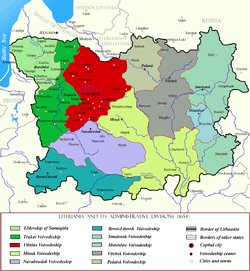Vilnius Voivodeship
| Vilnius Voivodeship Lithuanian: Vilniaus vaivadija Polish: Województwo wileńskie | |||||
| Voivodeship of Polish-Lithuanian Commonwealth | |||||
| |||||
|
| |||||
 | |||||
| Capital | Vilnius | ||||
| History | |||||
| • | Union of Horodło | 1413 | |||
| • | Third partition of the Polish–Lithuanian Commonwealth | 1795 | |||
| Area | 44,200 km2 (17,066 sq mi) | ||||
| Political subdivisions | counties: five | ||||
The Vilnius Voivodeship (Latin: Palatinatus Vilnensis, Lithuanian: Vilniaus vaivadija, Polish: województwo wileńskie) was one of voivodeships in the Grand Duchy of Lithuania, created in 1413, from the Duchy of Lithuania and neighbouring lands and later incorporated into the newly established Polish-Lithuanian Commonwealth.
Geography and administrative division
Geographically the area was centered on the city of Vilnius, which has always been the capital of the entity and the seat of a voivode. However, the actual territory of the voivodeship varied over time. Together with the Trakai Voivodeship it was known as Lithuania propria. Until the partitions of the Polish–Lithuanian Commonwealth the voivodeship was composed of five smaller units of administrative division named powiat (in Lithuanian: plural - pavietai, singular - pavietas), similar to British counties:
History
In 1413 the Union of Horodło introduced the title of voivode to the Grand Duchy of Lithuania. Before the reform, the area, centered on Vilnius, was known as the Duchy of Lithuania or sometimes as the Duchy of Vilnius. Vilnius Voivodeship became the capital voivodeship of the Grand Duchy of Lithuania.
After the Union of Lublin in 1569 which formed the Commonwealth, Grand Duchy retained much of its autonomy, and Vilnius Voivodeship remained its capital voivodeship, just as Vilnius remained its capital city, although the capital of the Commonwealth was first in Cracow (Cracow Voivodeship) and later in Warsaw (Masovian Voivodeship). In 1793, voivodeships of Breslauja and Merkinė (Merkinė was really part of Vinius, but considered nominally part of Smolensk) were created from northern part of it. Breslauja Voivodeship consisted from Breslauja, Vilkmergė and Anykščiai counties and Merkinė one conisisted from Merkinė, Prienai and Eišiškės ones.
After the partitions of the Polish–Lithuanian Commonwealth, the territory of Vilnius Voivodeship was incorporated into the Russian Empire, most of the territory becoming a part of Vilna Governorate. Northern part of it was passed to Kovno Governorate in 1843. After World War I former Vilnius Voivodeship was divided between Lithuania and Poland. After World War II, Soviet Union transferred most of Polish portion of the former voivodeship to Belarus SSR.
Voivodes

- Albertas Vaitiekus Manvydas (since 1413)
- Jonas Goštautas (since 1443)
- Mikalojus Radvila (since 1480)
- Mikolaj Radziwiłł (since 1507)
- Albertas Goštautas (since 1522)
- Jan Hlebowicz (since 1542)
- Mikołaj "the Black" Radziwiłł (since 1551)
- Krzysztof Mikołaj "Piorun" Radziwiłł (since 1584)
- Mikołaj Krzysztof "Sierotka" Radziwiłł (since 1604)
- Lew Sapieha (since 1621 or 1623)
- Krzysztof Radziwiłł (since 1633)
- Janusz Skumin Tyszkiewicz (1640–1642)
- Krzysztof Chodkiewicz (since 1642)
- Janusz Radziwiłł (since 1653)
- Paweł Jan Sapieha (since 1656)
- Michał Kazimierz Radziwiłł (since 1667)
- Michał Kazimierz Pac (since 1669)
- Jan Kazimierz Sapieha the Younger (since 1682)
- Jan Kazimierz Sapieha the Elder (since 1705)
- Michał Serwacy Wiśniowiecki (1706–1707 and 1735–1744)
- Michał Kazimierz "Rybeńko" Radziwiłł (since 1744)
- Michał Hieronim Radziwiłł (since 1755)
- Karol Stanisław "Panie Kochanku" Radziwiłł (1762–1764 and 1768–1790)
See also
Coordinates: 54°40′58″N 25°16′12″E / 54.682738°N 25.269943°E


